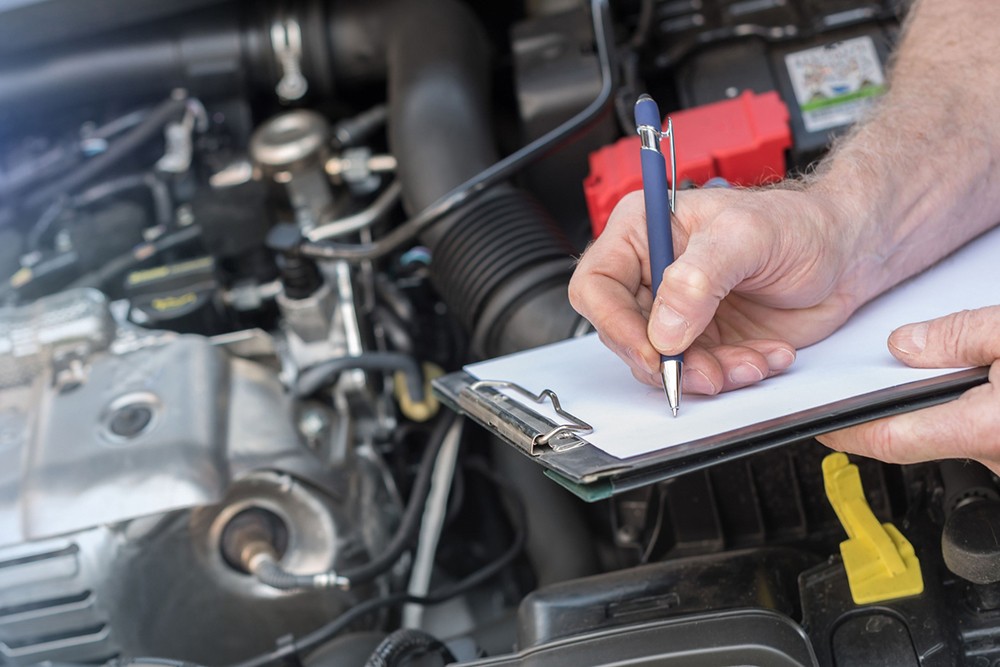12 Ways To Keep Your Vehicle Ready For Autumn Travel

by Jay Alling
You’ve stowed the camping equipment, racked the canoe and already set your sights on winter sports gear. What about taking stock of your vehicle?
“In late August we already had snow showers,” said Joshua Lewis of the Colorado State Troopers. “The biggest problem we see on autumn roadways is drivers who are not prepared for the arrival of inclement weather.
“Vehicles don’t have proper tires or tread depth.”
Trooper Lewis blamed tire issues for one of the most common autumn accidents: vehicles sliding into center meridians or street guardrails.
Faulty brake systems were identified by Trooper Lewis as another major issue. Hot summer roads wear down brake pad lining and put strain on other brake system components that can leave vehicles stranded.
“That tow truck you call may take hours to arrive.”
Those problems can turn up unexpectedly during autumn road trips, especially for trucks and large recreational vehicles.
“It comes down to knowing your vehicle and how it is supposed to operate,” said Trooper Lewis, who has worked as an officer for the past 15 years. “We perform regular inspections of vehicles for work, ideally daily.
“For me, I've found that the cost of routine maintenance and fixing minor problems on my personal vehicles saves a lot of money, time, and heartache later on.”
Officer Lewis rattled off a list of items he includes on his fall inspection list: tire tread depth, brake performance, windshield wiper replacement, battery charge, topping off fluids, properly functioning headlights.
An autumn inspection establishes the baseline for Officer Lewis’ vehicle’s health and also help him avoid surprises. It addresses issues related to summer driving–road construction, hot weather, miles piled up on the odometer.
Inspection report printout offers observations made by technicians. It helps keep your vehicle reliable for travel throughout Thanksgiving and into the New Year.
By revealing minor issues before they become major problems, the inspection report provides a roadmap for budgeting maintenance and repairs. Preparing for winter may uncover some additional considerations not needed for spring and summer travel.
For instance, areas prone to extreme cold may require coolant and windshield wiper fluid specially designed for sub-freezing temperatures. Winter fluids can help your vehicle perform better and start easier.
Routine inspection offers the most efficient way to monitor your vehicle’s overall health. A certified or factory-trained technician can help identify issues before they become expensive or life-threatening problems.
Talk to your service advisor before heading out on upcoming autumn excursions. Include the following items in your autumn multipoint inspection:
“Remember to slow down during those first storms of autumn,” Trooper Lewis said. “Pack some patience along with your cargo and family.”
- Tire tread wear. Rubber compounds wear fast on hot summer roads. Do you tires have enough tread to drive safely on slick roads? The inspection report and your service advisor can help decide.
- Inspect leaks, frayed hoses and worn belts. Cold weather makes old rubber as well as plastic parts harden and crack. As a result, minor leaks detailed on your autumn inspection report can turn into major repair bills if ignored.
- Test battery voltage. Vehicles require more starting power in winter. Also, cold temperatures can cause a failing battery to go dead overnight.
- Check battery cable connections and other charging components such as the alternator. Rust, corrosion and crusty terminals can reduce battery power.
- Replace wiper blades. Ultraviolet rays of summer dry out and crack wiper blades, rendering hardened blades ineffective during autumn storms. Old blades can scratch your vehicle windshield and create screeching sounds. They also reduce visibility.
- Consider specialized blades. If you live in an extremely cold environment, consider blades intended for ice and snow. They are made with rubber compounds intended to remain pliable in freezing temperatures.
- Inspect the climate control system for leaks and proper fluid. Also, make sure the window vents are free of obstructions and that the fan is operating properly.
- Ask about winter coolant intended for extreme cold temperatures. Usually, a 50/50 mix of coolant to water may suffice in most climates, your vehicle may need a different mixture in extreme zones. “No-freeze” fluids are not available in all states or counties.
- Check the windshield washer reservoir and fill to the recommended level. Wiper fluid gets used quickly during a single snowstorm or if you are traveling along grimy roadways.
- Inspect wiper spray nozzles for clogs or obstructions that may prevent proper operation when you need them most.
- Review the following tire-related concerns:
- Make sure tires are properly inflated (check manufacturer recommendations) and make sure there’s plenty of tread; check for uneven wear. It’s a sign something may be wrong with the tire and alignment.
- Do you have a spare tire? It needs to be inspected as well.
- Tire rubber degrades after several years. Older tires may need to be replaced even if they have not been used.
- Review your vehicle manual for seasonal recommendations. Ask whether your vehicle is due for a climate control system flush. If antifreeze hasn’t been replaced in several years, the fluid may have lost its effectiveness. Rust particles may clog the system and cause failure.